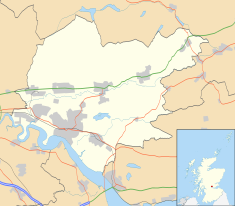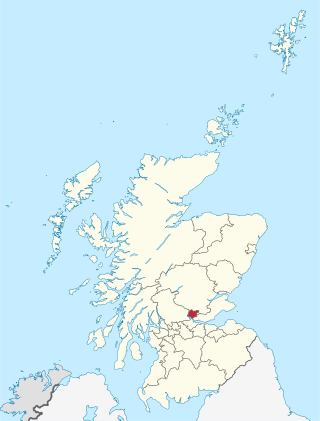
Clackmannanshire, or the County of Clackmannan, is a historic county, council area, registration county and lieutenancy area in Scotland, bordering the council areas of Stirling, Fife, and Perth and Kinross. In terms of historic counties it borders Perthshire, Stirlingshire and Fife.

Alloa is a town in Clackmannanshire in the Central Lowlands of Scotland. It is on the north bank of the Forth at the spot where some say it ceases to be the River Forth and becomes the Firth of Forth. Alloa is south of the Ochil Hills on the western Fife peninsula, 6.0 miles (9.7 km) east of Stirling and 13.0 miles (20.9 km) west of Dunfermline; by water Alloa is 25 miles (40 km) from Granton.
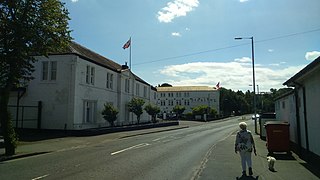
Tillicoultry is a town in Clackmannanshire, Scotland. Tillicoultry is usually referred to as Tilly by the locals.

Menstrie is a village in the county of Clackmannanshire in Scotland. It is about five miles east-northeast of Stirling and is one of a string of towns that, because of their location at the foothill base of the Ochil Hills, are collectively referred to as the Hillfoots Villages or simply The Hillfoots.

Alva is a small town in Clackmannanshire, set in the Central Lowlands of Scotland. It is one of a number of towns situated immediately to the south of the Ochil Hills, collectively referred to as the Hillfoots Villages or simply The Hillfoots. It is located between Tillicoultry and Menstrie. Alva had a resident population of 5,181 at the 2001 census but this has since been revised to 4,600 in 2016. It boasts many features such as a park with an event hall and a newly opened outdoor gym, and is the home of Alva Academy.

Tullibody is a town set in the Central Lowlands of Scotland. It lies north of the River Forth near to the foot of the Ochil Hills within the Forth Valley. The town is 1.8 miles (2.9 km) south-west of Alva, 1.8 miles (2.9 km) north-west of Alloa and 4.0 miles (6.4 km) east-northeast of Stirling. The town is part of the Clackmannanshire council area.
Patons and Baldwins was a leading British manufacturer of knitting yarn. It was an original constituent of the FT 30 index of leading companies on the London Stock Exchange.

Alloa railway station is a railway station in the town of Alloa, Clackmannanshire, Scotland, which was re-opened on Monday, 19 May 2008.

Sauchie Tower, also known as Devon Tower, is a 15th-century tower house in Clackmannanshire, Scotland. The tower is located by the village of Fishcross, 1 kilometre (0.62 mi) north of Sauchie and 2.5 kilometres (1.6 mi) north of Alloa, close to the River Devon. It is protected as a Scheduled Ancient Monument.

The church is named after Saint Mungo, patron saint and founder of the city of Glasgow. It belongs to the Church of Scotland Presbytery of Stirling and serves the parish of Alloa. A chapel dedicated to St Mungo is thought to have been erected during the fourteenth or fifteenth-century, which became dependent upon the Parish of Tullibody. Alloa had grown into a parish in its own right by 1600 when the Act of Assembly united the two parishes. In 1680, the original chapel was rebuilt and enlarged. The current church replaces the old parish church from the seventeenth-century which had been deemed much too small for the congregation for over seventy years and was declared ruinous and unsafe in August 1815. The condition of the old church was so bad that services were often being held in the open air rather than risking injury to the congregation The decision was finally made to abandon the old building and find a site for a new parish church. The Erskine family donated land at Bedford Place and work on the new St Mungo's church began in 1817. The church congregation temporarily worshipped in the Tabernacle until the completion in 1819 of the new church. Since land was judged at the time to have too great a value to the living to be set aside for the dead, no graveyard was planned or added to the new church. The more elaborate scale and design of the new building was intended to reflect the increased size and prosperity of the nineteenth-century congregation. The church was one of the largest in Scotland at the time it was built.

The Clackmannanshire Council election of 2017 was held on 4 May 2017, on the same day as the 31 other local authorities in Scotland. It was the third successive election to run under the STV electoral system and used the five wards created under the Local Governance (Scotland) Act 2004, with 18 councillors being elected.
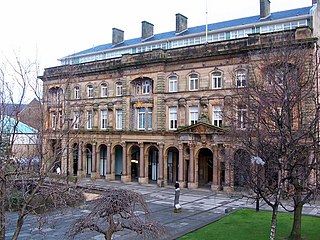
Greenock Municipal Buildings is a municipal structure in Clyde Square, Greenock, Scotland. The municipal buildings, which are the headquarters of Inverclyde Council, are Category A listed.

St Andrews Town Hall is a municipal structure in South Street, St Andrews, Fife, Scotland. The structure, which is the meeting place of the Royal Burgh of St Andrews Community Council, is a Category B listed building.

Rothesay Town Hall and County Buildings is a former municipal building in Castle Street, Rothesay, Scotland. The structure, which was the meeting place of Rothesay Burgh Council and of Bute County Council, is a Category B listed building.

Cove Burgh Hall is a municipal structure in Shore Road in Cove, Argyll and Bute, Scotland. The structure, which is used as a community events venue, is a Category B listed building.

Kinross Town Hall forms part of a complex of municipal buildings in the High Street, Kinross, Perth and Kinross, Scotland. The town hall, which has been converted for residential use, is a Category B listed building.

Anstruther Town Hall is a municipal building in School Green, Anstruther Easter, Fife, Scotland. The structure, which is used as a community events venue, is a Category B listed building.

Denny Town House is a municipal building in Glasgow Road, Denny, Falkirk, Scotland. The structure is used by Falkirk Council for the provision of local services.
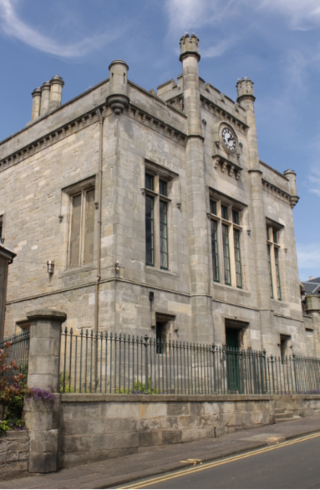
Kinghorn Town Hall is a municipal building in St Leonard's Place, Kinghorn, Fife, Scotland. The structure, which is used as holiday accommodation for tourists, is a Category B listed building.

County Buildings is a municipal structure in Drysdale Street, Alloa, Clackmannanshire, Scotland. The structure, which was the headquarters of Clackmannanshire County Council and is currently used as courthouse, is a Category B listed building.

